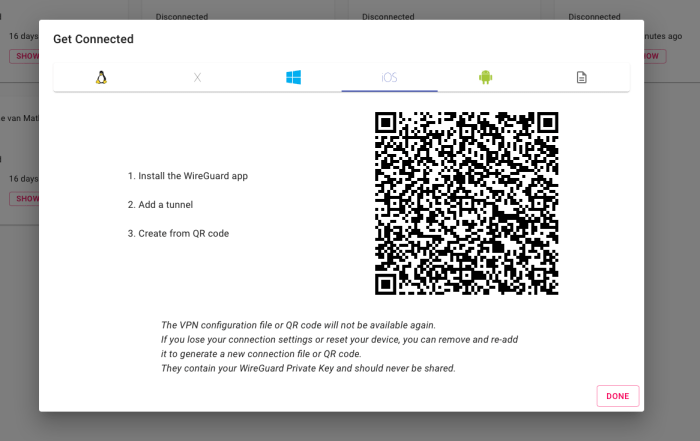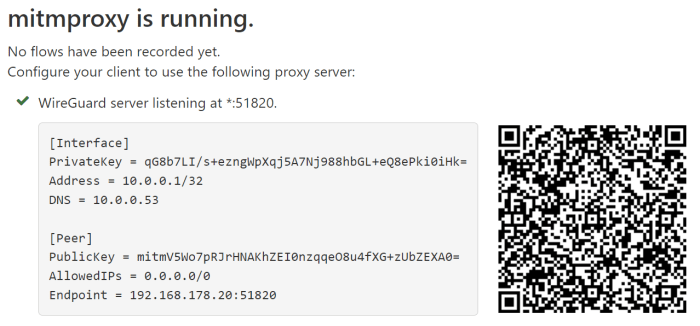SSH.SSHSlowdns.com – In the realm of network security, MikroTik WireGuard QR codes have emerged as a game-changer. These innovative codes offer a convenient and secure way to configure WireGuard VPN connections, simplifying the process for both network administrators and end-users.
This comprehensive guide will delve into the world of MikroTik WireGuard QR codes, exploring their purpose, functionality, and benefits. We will provide step-by-step instructions on generating, scanning, and importing these codes, ensuring a seamless and secure VPN experience.
Mikrotik WireGuard QR Code Overview
MikroTik WireGuard QR codes provide a convenient and secure way to configure WireGuard VPN connections on MikroTik routers. By scanning the QR code with a mobile device, users can automatically import all the necessary configuration settings, eliminating the need for manual input and reducing the risk of errors.The
benefits of using QR codes for WireGuard configuration include:
-
- -*Ease of use
QR codes simplify the configuration process, making it accessible to users of all technical levels.
- -*Ease of use
-*Reduced risk of errors
By eliminating the need for manual input, QR codes help to prevent configuration errors that could compromise the security of the VPN connection.
-*Increased efficiency
QR codes streamline the configuration process, saving time and effort for network administrators.
However, there are also some limitations to using QR codes for WireGuard configuration:
-
- -*Limited compatibility
QR codes are only compatible with devices that have a QR code scanner installed.
- -*Limited compatibility
-*Security concerns
If a QR code falls into the wrong hands, it could be used to gain unauthorized access to the VPN network.
-*Limited customization
QR codes only allow for the configuration of basic WireGuard settings. For more advanced configurations, manual input may still be required.
Overall, MikroTik WireGuard QR codes offer a convenient and secure way to configure WireGuard VPN connections on MikroTik routers.
While there are some limitations to their use, the benefits of QR codes often outweigh the drawbacks.
Generating MikroTik WireGuard QR Codes
Generating WireGuard QR codes using MikroTik RouterOS is a straightforward process that allows for easy and secure device configuration. These QR codes contain all the necessary information for establishing a WireGuard connection, simplifying the setup process and reducing the risk of errors.
To generate a WireGuard QR code using MikroTik RouterOS, you will need the following parameters:
- Private key: The private key associated with the WireGuard interface.
- Public key: The public key of the peer device that you want to connect to.
- Endpoint: The IP address or hostname of the peer device.
- Port: The port number used for the WireGuard connection.
- Allowed IPs: The IP address range that the peer device is allowed to access.
Once you have gathered these parameters, you can use the following command to generate a WireGuard QR code:
/tool wireguard qr generate key= public-key= endpoint= port= allowed-ips=
For example, the following command generates a QR code for a WireGuard connection with the following parameters:
- Private key: 0123456789abcdef0123456789abcdef
- Public key: 1234567890abcdef1234567890abcdef
- Endpoint: 192.168.1.1
- Port: 51820
- Allowed IPs: 192.168.1.0/24
/tool wireguard qr generate key=0123456789abcdef0123456789abcdef public-key=1234567890abcdef1234567890abcdef endpoint=192.168.1.1 port=51820 allowed-ips=192.168.1.0/24
The output of this command will be a QR code that can be scanned by the peer device to establish the WireGuard connection.
Scanning and Importing MikroTik WireGuard QR Codes
Scanning and importing MikroTik WireGuard QR codes is a convenient and efficient method to configure WireGuard connections on MikroTik devices. To scan and import a QR code, follow these steps:
- Open the MikroTik WebFig interface and navigate to the WireGuard settings page.
- Click on the “Import” button and select the “Scan QR Code” option.
- Use a QR code scanner app on your mobile device to scan the QR code generated by the MikroTik device.
- Once the QR code is scanned, the WireGuard configuration will be automatically imported into the MikroTik device.
MikroTik WireGuard QR codes are compatible with most QR code scanner apps on iOS and Android devices. Ensure your device has a working camera and sufficient lighting to capture the QR code accurately.If you encounter any issues while scanning or importing MikroTik WireGuard QR codes, try the following troubleshooting tips:
- Ensure that the QR code is clear and not damaged.
- Try using a different QR code scanner app.
- Verify that your mobile device has a stable internet connection.
- Restart the MikroTik device and try scanning the QR code again.
Customizing MikroTik WireGuard QR Codes
Customizing MikroTik WireGuard QR codes allows you to tailor their appearance, size, and data content to suit your specific needs. This can enhance the functionality and aesthetic appeal of the QR codes, making them more visually appealing and easier to use.
Modifying QR Code Appearance
You can customize the appearance of MikroTik WireGuard QR codes by adjusting their color scheme, adding logos or watermarks, and modifying their shape. This can help to create unique and recognizable QR codes that stand out from the crowd.
Adjusting QR Code Size
The size of a MikroTik WireGuard QR code can be adjusted to fit different spaces and applications. Larger QR codes are easier to scan from a distance, while smaller QR codes can be integrated into smaller spaces.
Modifying QR Code Data Content
In addition to customizing the appearance and size of MikroTik WireGuard QR codes, you can also modify their data content. This includes adding additional information, such as contact details or website addresses, to the QR code. This can make the QR code more versatile and provide additional value to users.
Integrating MikroTik WireGuard QR Codes with Mobile Devices

Integrating MikroTik WireGuard QR codes with mobile devices offers a seamless and convenient method for configuring WireGuard connections on the go. By utilizing mobile apps designed for scanning and importing QR codes, users can effortlessly establish secure and private VPN connections to their MikroTik routers.
Scanning and Importing QR Codes Using Mobile Apps
To scan and import MikroTik WireGuard QR codes using mobile apps, follow these simple steps:
- Install a QR code scanner app on your mobile device.
- Open the app and point the camera at the MikroTik WireGuard QR code.
- The app will automatically scan and decode the QR code, displaying the configuration details.
- Tap the “Import” or “Add” button to import the configuration into your mobile device’s VPN settings.
- Enter the necessary credentials, such as your username and password, and connect to the VPN.
Optimizing the Mobile Experience
To enhance the mobile experience when using MikroTik WireGuard QR codes, consider the following tips:* Use a QR code scanner app that is specifically designed for scanning WireGuard QR codes.
- Ensure that your mobile device’s camera is properly focused and has adequate lighting.
- If the QR code is damaged or obscured, try to obtain a new one from your MikroTik router.
- Keep your mobile device’s VPN settings up to date to ensure optimal performance and security.
Troubleshooting MikroTik WireGuard QR Code Issues

Utilizing MikroTik WireGuard QR codes can occasionally present challenges. This section will identify common issues and provide troubleshooting steps to resolve them.
QR Code Scanning and Import Errors
If you encounter difficulties scanning or importing a MikroTik WireGuard QR code, consider the following:
- Ensure the QR code is generated correctly and printed clearly.
- Verify that your device’s camera is focused and well-lit.
- Try using a different QR code reader application.
Configuration Problems
If you experience issues after scanning and importing a MikroTik WireGuard QR code, check the following:
- Confirm that the WireGuard interface is enabled and configured correctly.
- Ensure that the public key and IP address in the QR code match the values in your WireGuard configuration.
- Verify that the firewall rules allow traffic through the WireGuard interface.
Best Practices for Using MikroTik WireGuard QR Codes
Effective utilization of MikroTik WireGuard QR codes requires careful consideration of security and best practices. By following these guidelines, you can maximize the benefits and minimize potential risks:
- Use strong encryption: Ensure your WireGuard QR codes are encrypted using strong algorithms like AES-256 or ChaCha20 to protect sensitive data.
- Limit distribution: Share QR codes only with authorized individuals and avoid posting them publicly. Consider using secure channels like email or messaging apps for distribution.
- Revoke compromised codes: If a QR code is compromised, revoke it immediately to prevent unauthorized access. MikroTik’s QR code management tools allow for easy revocation.
- Regularly review and update: Regularly review your QR codes and update them as needed to maintain security and functionality.
Recommended Usage Scenarios:
- Remote access: Grant secure remote access to employees or contractors without exposing network credentials.
- Device onboarding: Simplify the onboarding process for new devices by providing a QR code that automatically configures WireGuard settings.
- Network segmentation: Create isolated network segments by assigning different QR codes to different groups of users.
Advanced MikroTik WireGuard QR Code Features
MikroTik WireGuard QR codes offer a range of advanced capabilities that enhance their versatility and functionality.
Dynamic QR Codes
Dynamic QR codes are a type of QR code that can be updated and modified over time. This feature is particularly useful for scenarios where the information encoded in the QR code needs to be changed frequently, such as for temporary access or changing network configurations.
RADIUS Authentication Integration
MikroTik WireGuard QR codes can be integrated with RADIUS authentication systems. This integration allows for additional security by requiring users to authenticate with a username and password before connecting to the WireGuard VPN.
Real-World Applications of MikroTik WireGuard QR Codes

MikroTik WireGuard QR codes offer practical solutions for streamlining network management. These codes can simplify complex configurations, enhance security, and facilitate remote access in various industries.
Streamlining Network Setup
QR codes eliminate the need for manual configuration by providing a quick and error-free way to establish WireGuard connections. Network administrators can generate codes with predefined settings and distribute them to users, allowing them to connect seamlessly with minimal effort.
Enhancing Security
QR codes provide an added layer of security by eliminating the risk of human error in entering sensitive information. The codes are encrypted and can be scanned only by authorized devices, preventing unauthorized access to network resources.
Facilitating Remote Access
QR codes enable users to connect to a network remotely by scanning the code with their mobile devices. This simplifies remote access for employees, contractors, or other authorized personnel, allowing them to connect securely from anywhere with an internet connection.
Industry-Specific Applications
- IT Management: QR codes streamline IT management by providing easy access to network configurations, documentation, and troubleshooting tools.
- Education: QR codes can be used to provide students with secure access to educational resources and online learning platforms.
- Healthcare: QR codes can facilitate secure patient data transfer, remote consultations, and medication management.
Future Developments and Innovations in MikroTik WireGuard QR Codes
The future of MikroTik WireGuard QR codes holds exciting possibilities as the technology continues to evolve. Here are some potential developments and innovations: